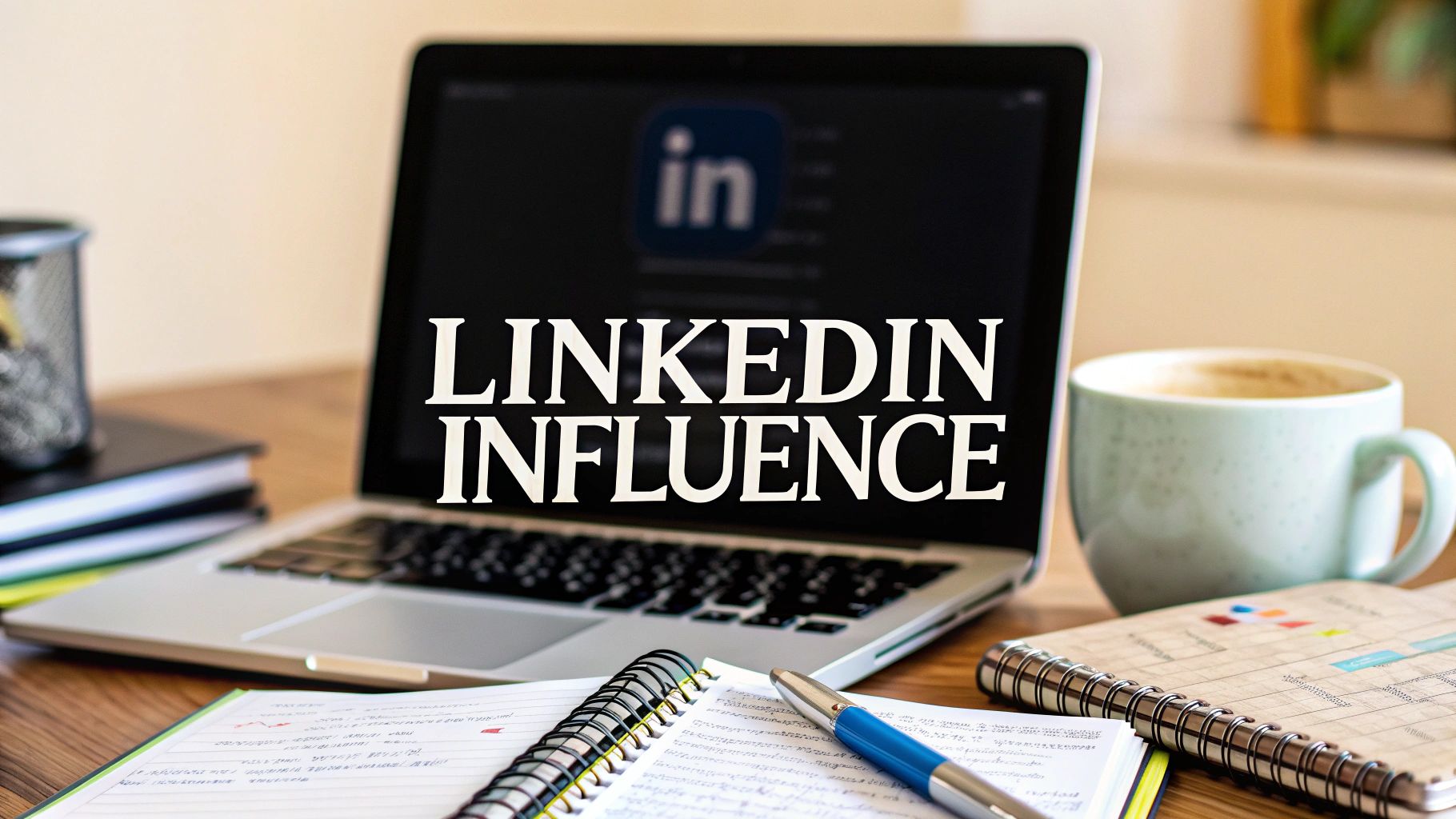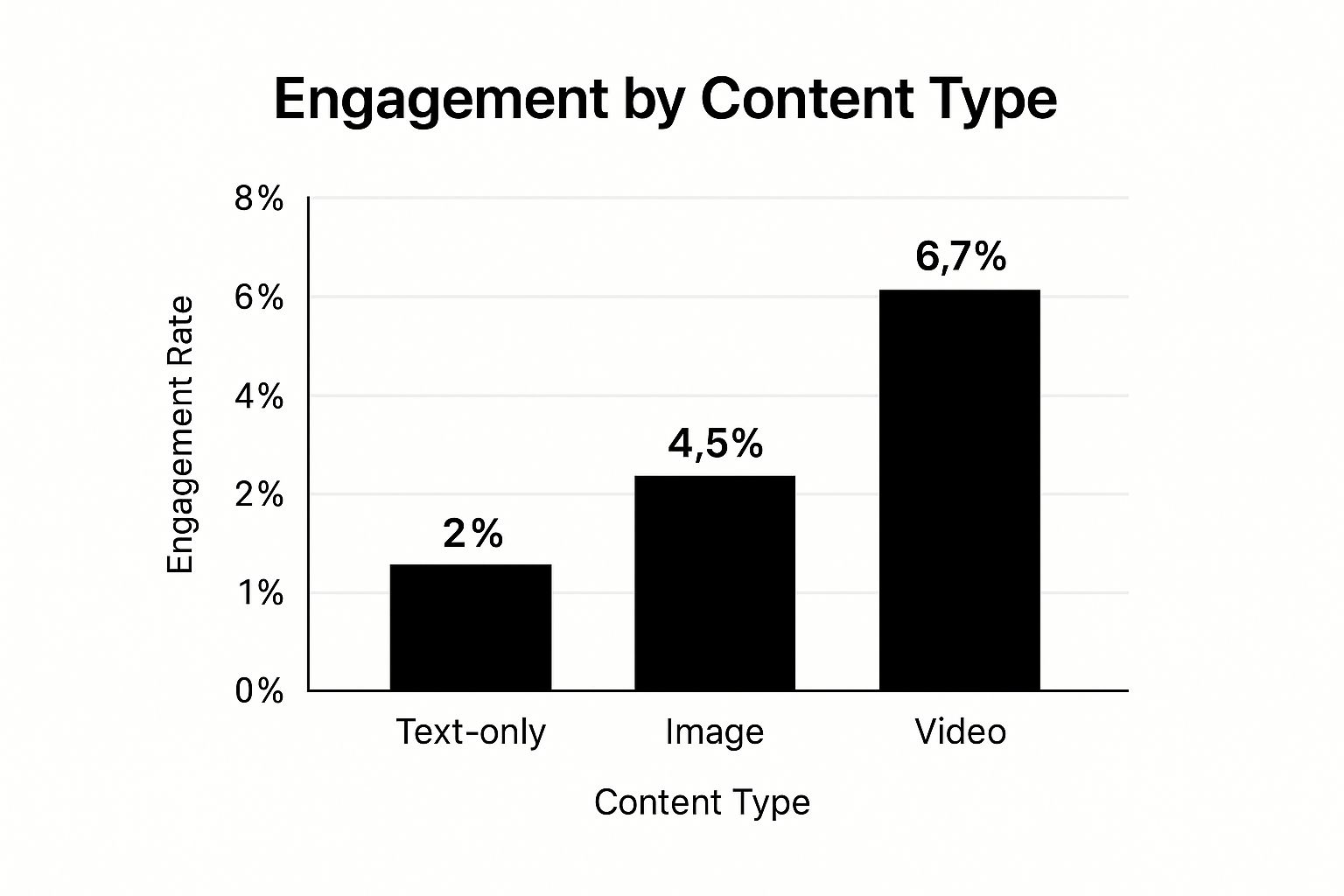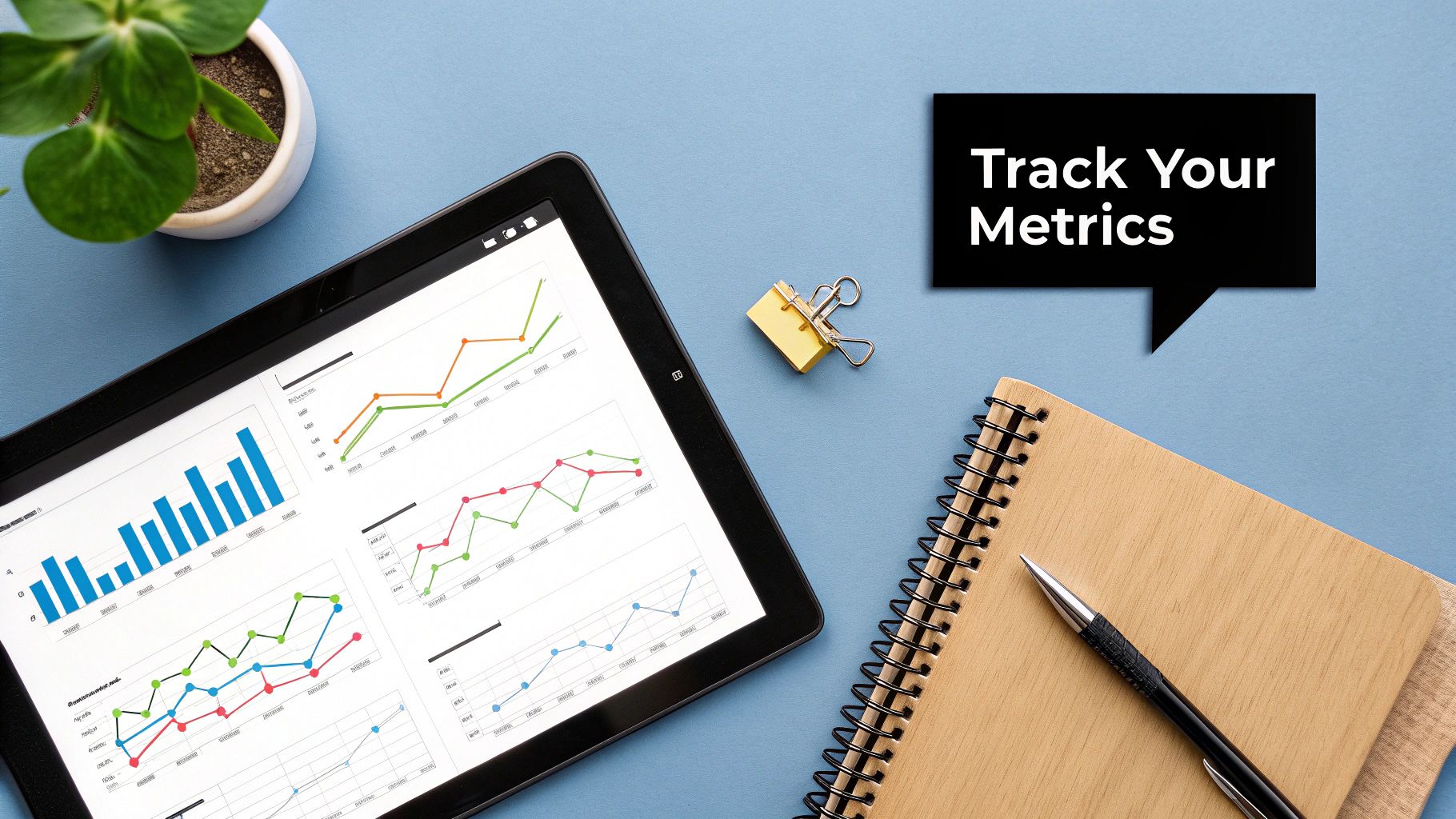
Content Strategy LinkedIn: Boost Your Professional Influence
Published on 2025-06-16
Understanding LinkedIn's Professional Content Game
LinkedIn isn't like other social media platforms. It's where professionals connect, share ideas, and even make business decisions. I've learned from experience (and from plenty of other B2B marketers) that treating LinkedIn like Instagram is a surefire way to hear crickets. People use LinkedIn differently. They're checking it during their lunch break, between meetings, or even while waiting for their morning coffee. They're looking for valuable insights to help them in their careers, not just funny memes. That makes it a really powerful platform for anyone who understands the nuances of professional networking.
This professional context makes LinkedIn unique. Think about it: your connections are potential clients, collaborators, or even future employers. Sharing insightful content isn't just about getting likes; it's about building your credibility and establishing yourself as a valuable resource in your field. It's all about showing what you know and offering genuine value to your network.
That’s why having a solid LinkedIn content strategy is so important. It's not enough to just post randomly. You need a plan. What kind of content resonates with decision-makers? What are they searching for on LinkedIn? How can you position yourself as someone they can turn to for valuable insights?
This all matters because LinkedIn is a highly engaged platform. Think about your own LinkedIn experience. Do you just passively scroll? Or do you comment, share, and engage with posts that pique your professional interest? This active engagement creates amazing opportunities. LinkedIn has become a powerhouse for content, especially in the B2B space. As of early 2025, the platform boasts over 1.2 billion members, making it the largest professional network worldwide. What sets LinkedIn apart is its engagement: users aren't just passively scrolling; they're actively interacting with content that aligns with their professional interests. A 2024 Social Media Content Strategy Report referenced by Sprout Social found that a quarter of LinkedIn users interact with brand content daily, while about half log in a few times a week, creating a consistent audience for smart content marketers. This high level of engagement makes LinkedIn the perfect place to build real, valuable business relationships through strategic content.
To help visualize how LinkedIn differs from other social media platforms, let's look at the table below:
LinkedIn vs Other Social Platforms: Professional Content Comparison
This table breaks down the key differences in how you should approach your content strategy across various platforms.
| Platform | Primary Audience | Content Type | Engagement Style | Best Use Case |
|---|---|---|---|---|
| Professionals, Businesses | Industry insights, Career advice, Thought leadership | Discussions, Sharing articles, Networking | Building professional brand, Generating leads, Recruiting talent | |
| Friends, Family, Interest groups | Personal updates, News, Entertainment | Likes, Comments, Shares | Connecting with friends, Building communities, Promoting local businesses | |
| General public, News outlets, Influencers | Short updates, Breaking news, Opinions | Retweets, Replies, Hashtags | Sharing real-time information, Engaging in public discourse, Building a following | |
| Individuals, Brands, Influencers | Visual content, Lifestyle, Inspiration | Likes, Comments, Stories | Building a visual brand, Showcasing products, Influencer marketing |
As you can see, LinkedIn emphasizes professional content and engagement, unlike the more personal or news-driven focus of other platforms. This highlights the need for a tailored approach to LinkedIn, focusing on providing value and building professional relationships.
What Actually Gets People Engaged on LinkedIn

This screenshot gives you a peek into a typical LinkedIn analytics dashboard. Notice the breakdown of key metrics like impressions, clicks, and engagement? This data is pure gold when it comes to fine-tuning your LinkedIn content strategy. By really digging into this information, you can get a clear picture of what’s resonating with your audience and what needs a little extra love. For example, a ton of impressions but very few clicks? That might be a sign that your headlines aren't quite as captivating as they could be. Let’s explore why this happens.
Creating truly engaging LinkedIn content isn't a game of chance. It's about understanding what makes professionals tick...in a professional environment. I've seen so many posts completely miss the mark because they lacked a clear purpose or felt too pushy and sales-y. Remember, quality trumps quantity every time. One thoughtfully crafted post will always outperform ten generic updates.
One major mistake I see often is neglecting the visual aspect of LinkedIn. People are naturally drawn to images and videos, especially on platforms like LinkedIn where we’re all constantly scanning and scrolling. Try incorporating high-quality images that reinforce your message. Even better? Short videos offering quick, digestible insights.
Think about LinkedIn Carousels, too. They're fantastic for presenting multiple pieces of information in a way that’s easy to consume. Carousels encourage people to interact with your content, spending more time with it, and that sends positive signals to LinkedIn’s algorithm. Want to dive deeper into crafting engaging posts? Check out this helpful resource: how to write engaging LinkedIn posts.
Timing is another critical piece of the puzzle. I’ve personally found that posting during standard business hours often gets lost in the shuffle. Experiment with posting before or after the typical 9-to-5, or even during lunch breaks when people might be more inclined to take a breather and engage. This is where understanding your specific audience really comes into play. Think about their daily routines. When are they most active on the platform?
Finally, remember that LinkedIn engagement is its own unique beast. The average engagement rate hovers around 2.8%. This tells us that LinkedIn users are selective, but they will actively participate with content that speaks to them. It's also worth noting that LinkedIn video content gets five times more engagement than text-only posts, and live video streams outperform pre-recorded videos by a whopping 24 times in terms of interaction. This means a smart LinkedIn content strategy needs to incorporate video whenever possible. Learn more about how to maximize your reach with LinkedIn engagement statistics.
Crafting Your Content Framework That Actually Works
Building a thriving presence on LinkedIn doesn't happen by chance. Those folks with huge, engaged followings aren't just winging it. They've figured out what makes them valuable and create consistent content around those core themes – their content pillars. This isn’t about mimicking someone else; it’s about figuring out your unique value proposition. If you're curious, check out this helpful resource: our comprehensive guide on content strategy for LinkedIn.
Understanding Your LinkedIn Audience
Knowing your audience on LinkedIn is critical, but typical social media research tactics often miss the mark. Instead of getting bogged down in demographics, think about your audience's professional needs and pain points. What keeps them up at night? What kind of information would truly help them in their day-to-day work lives? I've found that just talking to a few ideal clients or connections can reveal a goldmine of information. Ask them point-blank what they'd find valuable on LinkedIn.
Competitive Analysis: Finding Your Edge
Competitive analysis isn't just about keeping tabs on the competition; it’s about finding the opportunities they are missing. Take a look at your competitors' LinkedIn content. What are they talking about? What are they not talking about? Where can you offer a different perspective or unique insight? That’s how you stand out and become a go-to expert in your field.
Creating a Balanced Content Calendar
Walking the tightrope between providing real value and subtly promoting your business is key to a successful LinkedIn content calendar. Too much self-promotion? People will tune you out. Too little? You'll miss opportunities. The infographic below shows the average engagement rates for different types of content on LinkedIn. It’s a great place to start when planning your content mix:

Notice how while text posts are great for sharing quick thoughts, adding visuals like images and especially videos, really boosts engagement. This underscores the importance of having a diverse content strategy on LinkedIn. Finding that sweet spot where valuable content and subtle promotion meet is the magic formula.
To illustrate how to organize your content for maximum impact, take a look at the table below. It provides a practical framework for structuring your content pillars and planning your posting schedule.
Content Pillar Framework for LinkedIn Success A strategic breakdown of different content types and their optimal frequency for maximum engagement
| Content Pillar | Post Frequency | Engagement Rate | Best Format | Target Audience |
|---|---|---|---|---|
| Industry Insights & Trends | 1-2 times/week | Medium-High | Articles, Text posts with links | Professionals in your industry |
| Company News & Updates | 1-2 times/week | Medium | Text posts, Images, Videos | Customers, Partners, Potential Employees |
| Thought Leadership & Opinions | 2-3 times/week | High | Long-form posts, Articles, Videos | Industry peers, Decision-makers |
| Career Advice & Mentorship | 1 time/week | Medium | Text posts, Short videos | Junior professionals, Students |
| Client Success Stories & Case Studies | 1 time/week | Medium-High | Videos, Images, Text posts with links | Potential clients, Existing clients |
This framework gives you a clear idea of what types of content to focus on and how often to post them. Remember, these are just starting points. You can adjust them based on your specific audience and goals. Experiment, see what resonates best, and refine your strategy over time.
Maximizing LinkedIn's Hidden Content Features

So, you’re posting regularly on LinkedIn, engaging with your network, and seeing some decent results. Awesome! But I’m willing to bet you’re only scratching the surface of what LinkedIn can really do for you. The platform has some seriously powerful features that most people just completely ignore. And these aren’t just fancy add-ons—they can dramatically boost your content’s reach and impact.
One of the biggest game-changers is employee advocacy. Your team members are a goldmine of potential brand ambassadors, each with their own network and influence. I’ve personally witnessed companies revitalize their LinkedIn presence simply by encouraging their employees to share and engage with company content. It’s like having a built-in network effect, and it feels way more authentic than just broadcasting from a company page.
Another fantastic (and often underused) tool is LinkedIn’s collaborative articles feature. This lets you team up with other thought leaders to co-create content, reaching a broader audience and forging new relationships at the same time. It's a win-win situation: you gain exposure to a new network, and your collaborator benefits from your reach. Plus, in my experience, collaborative pieces tend to spark more conversation and engagement than solo posts.
Of course, even with these advanced tactics, your LinkedIn content strategy needs a strong foundation. This means understanding how hashtags really work on the platform. It’s not enough to just sprinkle in a few popular tags. Strategic hashtag use involves research. You need to know which hashtags your ideal audience is actually following and engaging with.
Then there’s native content optimization – basically, creating content directly on LinkedIn. The algorithm loves this stuff, giving it preferential treatment in the feed. Think native videos, LinkedIn articles, and even simple text posts that ignite conversations. It’s all about playing with the platform, not against it. That also means steering clear of common mistakes, like posting overly promotional content or ignoring comments. LinkedIn’s algorithm prioritizes authentic engagement, so genuine interaction is key.
It’s important to understand the impact these tactics can have. Data shows that employee activity drives about 30% of a company’s overall engagement on LinkedIn, which really underscores the power of empowering your staff to share and interact with company content. Since their launch, the platform's AI-powered collaborative articles have seen over 10 million contributions and a whopping 270% increase in weekly readership. Discover more insights on LinkedIn statistics. Combining these hidden features with a smart hashtag strategy and native content optimization can seriously level up your LinkedIn content game.
Turning Connections Into Real Business Opportunities
It’s awesome to build a solid LinkedIn following, right? But honestly, it’s only half the equation. I’ve seen countless creators hit a wall here. They’re pulling in crazy engagement numbers, but those likes and comments just aren’t translating into actual business. That’s where relationship nurturing comes in. The LinkedIn pros understand it’s not about the hard sell. It's about building authentic relationships that organically create opportunities. They’re all about providing consistent value through their content, becoming go-to experts in their communities.
Storytelling That Resonates With B2B
B2B audiences aren’t scrolling through cat videos—they’re looking for usable information, not just entertainment. Think about it: they’re often on LinkedIn during the workday, searching for knowledge that will help them succeed. This calls for a different kind of storytelling. Ditch the fluff and focus on clear, concise messaging that gets right to the point. In my experience, case studies and real-world examples are absolute gold. Sharing relatable experiences and showing tangible results through your content is how you grab—and hold—a B2B audience’s attention.
Showcasing Your Value Without Being Salesy
Becoming a thought leader doesn’t mean every post is a sales pitch. There’s a real knack to showcasing your skills without being pushy. Remember the "show, don’t tell" rule? Instead of bragging about your achievements, let your case studies speak for themselves. For instance, instead of declaring, "I'm a lead generation guru," tell a story about how you helped a client boost their leads by 20%. This quietly shows off your abilities while giving your audience actionable insights. Everybody wins. Subtlety is your superpower on LinkedIn.
Lead Generation That Feels Natural
LinkedIn is a professional space, so in-your-face sales tactics often bomb. The best lead generation strategies feel natural and unobtrusive. One approach I’ve seen work wonders is offering valuable resources in exchange for contact info. Maybe create a downloadable guide relevant to your industry and offer it to your connections for their email address. This gives them something useful while letting you gather leads organically within the LinkedIn environment. Tools like LinkedIn Sales Navigator can also be game-changers for targeted outreach.
This screenshot shows the LinkedIn Sales Navigator interface—a serious powerhouse for finding and connecting with potential leads. See those filtering options? You can tailor your search by industry, job title, location, and a whole lot more, so you’re reaching the right people who are most likely to be interested in what you offer. This focused approach really amps up your outreach effectiveness.
Turning connections into business opportunities is a mindset shift. It’s about building relationships, not just collecting contacts. If you're thinking about making money from your LinkedIn presence, check out this guide on how to monetize LinkedIn. By consistently providing value and nurturing your network, business opportunities will start to appear naturally. The bottom line? In the long run, genuine connections are the bedrock of sustainable growth on LinkedIn.
Measuring What Actually Matters for LinkedIn Success

LinkedIn gives you a ton of analytics, but it's easy to get bogged down. I see so many people obsessing over vanity metrics like how many followers they have or how many impressions their posts get. Sure, it’s nice to see those numbers go up, but they don't tell the whole story. The people I know who are really killing it on LinkedIn, consistently generating leads and actual business, focus on metrics tied to business growth. They dig deeper than surface-level engagement to find out what truly clicks with their audience and gets results.
Beyond Vanity: Metrics That Drive Business
So, what should you be looking at? It boils down to figuring out where your content fits in your sales funnel. For example, at the top of the funnel, your engagement rate tells you a lot about your content quality and audience interest. A high engagement rate means your content is hitting the mark and starting conversations—essential for building brand awareness. This means going beyond just likes and comments. Think shares and click-through rates. Are people clicking on your links and taking action on your calls to action?
Further down the funnel, you'll want to keep an eye on lead generation metrics. Think website visits from LinkedIn, content downloads, or demo requests. These metrics show if your content is actually pushing potential customers closer to doing business with you. And of course, tracking conversions—the percentage of leads that become paying customers—is crucial for understanding the ROI of your LinkedIn content strategy.
LinkedIn's Native Analytics: A Powerful Tool
LinkedIn’s built-in analytics are a goldmine for measuring these metrics. They give you a detailed breakdown of how each post performs, including impressions, clicks, engagement, and demographics. But the real magic is knowing how to interpret all that data. For example, lots of impressions but low engagement? That could mean your content isn't resonating with the right people, or your headlines aren't catchy enough. This is where A/B testing comes in.
A/B Testing: Finding What Works Best
A/B testing is basically creating two slightly different versions of your content and seeing which one performs better. Maybe you test different headlines, images, or calls to action. By systematically testing these variations, you learn what your specific audience responds to best and can fine-tune your LinkedIn content strategy for optimal results. This is about taking the guesswork out and using data to make smart decisions.
Benchmarks and Industry Standards
Finally, keep in mind that “success” on LinkedIn looks different for every industry. A 2% engagement rate might be fantastic for a huge company, while a smaller business might shoot for 5% or higher. Researching industry benchmarks and seeing what your competitors are up to will help you set realistic goals and measure your progress effectively. It’s not about chasing random numbers, but about creating a LinkedIn content strategy that consistently delivers real business opportunities.
Your LinkedIn Content Strategy Action Plan
Alright, let's get down to brass tacks and transform all this information into a practical roadmap you can use right now. This isn't some pie-in-the-sky theory; think of it as a 90-day action plan built on what's actually worked for others who've successfully grown their presence on LinkedIn.
The First 30 Days: Building Your Foundation
This first month is all about setting the stage. It's about figuring out who you’re connecting with, the topics you’ll cover, and how you’ll deliver your message.
Think of it like building a house. You wouldn't start slapping on paint before laying the foundation, right? Same principle here.
Week 1: Audience & Niche Definition. First things first: who are you talking to? And what specific area of expertise are you focusing on? Don't just throw darts at a board – talk to actual people in your network! A few quick chats can unlock incredible insights. Consider what they struggle with and how your expertise can provide solutions.
Week 2: Profile Optimization. Now, polish that profile like you’re prepping for a job interview. Think of your headline, summary, and experience sections as your LinkedIn elevator pitch. They should instantly communicate your value proposition. Would you hire you based on your current profile?
Week 3: Content Pillars & Calendar. What 3-5 core themes will be the backbone of your content? Map out your first month’s worth of posts, aiming for 2-3 posts per week. Experiment with different formats – articles, videos, text posts – to see what resonates. Think variety!
Week 4: Initial Engagement. Time to get social! Start commenting on posts from your target audience, join relevant LinkedIn Groups, and share valuable content from others. This is how you begin building genuine relationships within your niche.
Days 31-60: Content Creation and Experimentation
Now that you have a solid foundation, it's time to put your plan into action and see what sticks. Think of this phase as a lab experiment.
Week 5-6: Content Creation Sprint. Roll up your sleeves and focus on creating high-quality content based on your calendar. Remember to experiment with different formats like LinkedIn carousels. Don't be afraid to try new things!
Week 7: Performance Analysis. Time to check your LinkedIn analytics. What content is your audience loving? What's falling flat? Don't be discouraged if some posts don't perform as expected. These are valuable learning opportunities.
Week 8: A/B Testing. Take your top-performing posts and A/B test different variations. Experiment with headlines, visuals, and calls to action to see what drives better results. Sometimes even small changes can yield significant improvements.
Days 61-90: Scaling and Optimization
You've found your groove; now it's time to ramp up your efforts and fine-tune your strategy.
Week 9-10: Amplify Your Reach. Start exploring LinkedIn's advanced features. Encourage employee advocacy and get your team involved! Consider collaborating with others in your space on joint articles or projects to expand your reach.
Week 11: Advanced Analytics Deep Dive. Look beyond the vanity metrics. Are your posts generating leads? Driving traffic to your website? This is where tools like LinkedIn Sales Navigator can be a game-changer.
Week 12: Refine and Repeat. Take all your learnings from the past few months and adjust your LinkedIn content strategy accordingly. Keep creating, engaging, and optimizing. Remember, consistency is key!
This isn’t a one-size-fits-all plan, so feel free to adapt it to your specific needs. Building a strong LinkedIn presence takes time and effort. It's a marathon, not a sprint. Speaking of making things easier, check out autoghostwriter (https://autoghostwriter.com) – it’s a great tool for quickly creating engaging LinkedIn content using AI. It can help you generate post ideas, write compelling copy, and even create visuals, saving you a ton of time.